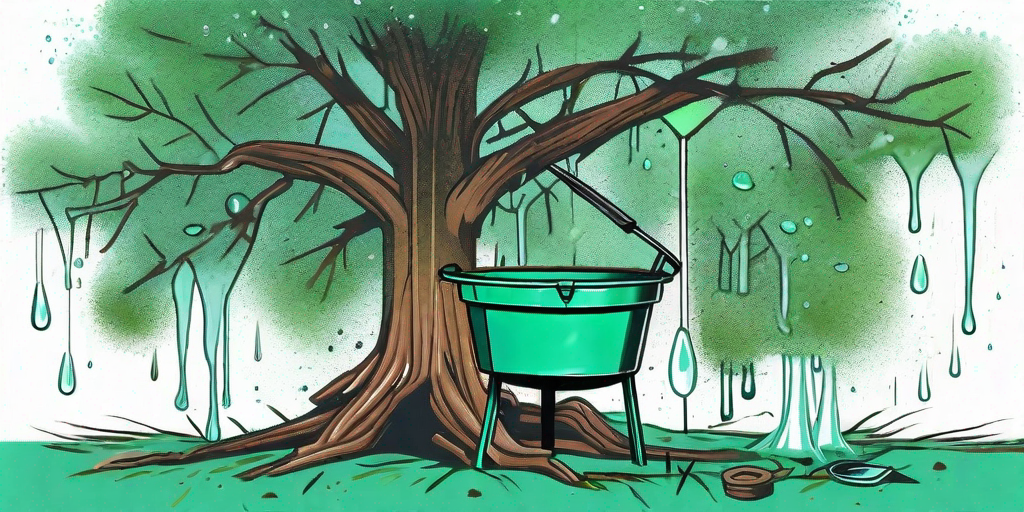
Ah, the pecan tree. A majestic sight to behold, a provider of delicious nuts, and a source of... sticky, sticky sap. If you're a proud owner of a pecan tree, or perhaps an entire grove, you're likely well-acquainted with this sticky situation. But fear not, dear reader, for we have the solutions to your sap woes right here.
Understanding Pecan Tree Sap
Before we dive into the nitty-gritty of sap removal, it's important to understand what we're dealing with. Pecan tree sap, like all tree sap, is a type of fluid transported in xylem cells of a tree. It contains water, mineral elements, hormones and other nutrients. It's the tree's way of feeding itself and healing its wounds. So, in a way, it's the tree's lifeblood. But when it gets on your car, clothes, or patio furniture, it's less lifeblood and more nuisance.
Now, you might be wondering, why is my pecan tree producing so much sap? Well, there could be a few reasons. It could be a natural response to the changing seasons, or it could be a sign of stress or damage. If you notice an excessive amount of sap, it might be worth having a tree care professional take a look.
Seasonal Sap Flow
Just like us humans, trees have their own rhythms and routines. In the case of pecan trees, they tend to produce more sap in the spring and summer months. This is a natural process and nothing to be alarmed about. However, it does mean that you might find yourself in a sticky situation more often during these times.
Stress or Damage
On the other hand, if your pecan tree is producing a lot of sap outside of the spring and summer months, it could be a sign of stress or damage. This could be due to a variety of factors, such as pests, disease, or physical damage. In these cases, it's best to consult with a tree care professional to determine the best course of action.
Removing Pecan Tree Sap
Now that we've covered the why, let's get to the how. Removing pecan tree sap can be a bit of a challenge, but with the right tools and techniques, it's definitely doable. Here are some methods you can try.
From Your Car
There's nothing quite like the sight of a shiny, clean car. But when that car is covered in tree sap, the shine quickly fades. Luckily, there are a few methods you can try to remove the sap and restore your car's sparkle.
One method is to use a commercial bug and tar remover. These products are designed to break down the sticky substances without damaging your car's paint. Simply spray the product onto the sap, let it sit for a few minutes, then wipe it off with a soft cloth.
Another method is to use rubbing alcohol. Apply a small amount to a cloth and gently rub the sap until it comes off. Be sure to rinse the area with water afterwards to remove any residue.
From Your Clothes
Tree sap and clothes are a combination that no one wants. But don't despair, your favorite shirt isn't ruined just yet. Here are a few methods you can try to remove the sap.
One method is to use rubbing alcohol. Apply a small amount to a cloth and gently rub the sap until it comes off. Then, wash the garment as usual. Be sure to check the care label first to make sure it's safe to use alcohol on the fabric.
Another method is to use dish soap and hot water. Apply the soap directly to the sap and rub it in with your fingers. Then, rinse the area with hot water. Repeat as necessary until the sap is gone, then wash the garment as usual.
Preventing Pecan Tree Sap
As the old saying goes, prevention is the best medicine. While you can't stop your pecan tree from producing sap, there are a few things you can do to minimize the impact on your property.
Regular Tree Care
Regular tree care is key to preventing excessive sap production. This includes regular watering, fertilizing, and pruning. A healthy tree is a happy tree, and a happy tree is less likely to produce excessive sap.
Strategic Placement
If you're planning on planting a new pecan tree, consider its placement carefully. Avoid planting it near cars, clotheslines, or patio furniture to minimize the risk of sap damage.
FAQs
- Why is my pecan tree producing so much sap?
It could be a natural response to the changing seasons, or it could be a sign of stress or damage. If you notice an excessive amount of sap, it might be worth having a tree care professional take a look.
- How do I remove pecan tree sap from my car?
You can use a commercial bug and tar remover or rubbing alcohol. Be sure to rinse the area with water afterwards to remove any residue.
- How do I remove pecan tree sap from my clothes?
You can use rubbing alcohol or dish soap and hot water. Be sure to check the care label first to make sure it's safe to use alcohol on the fabric.
- How can I prevent pecan tree sap?
Regular tree care and strategic placement can help minimize the impact of sap on your property.
So there you have it, folks. Dealing with pecan tree sap might be a sticky situation, but it's certainly not an insurmountable one. With a little knowledge and a few handy techniques, you can keep your property sap-free and your pecan tree happy. Now, if only dealing with life's other sticky situations was this easy!











